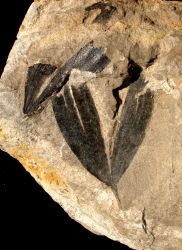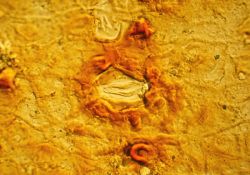Ginkgo-like plants from Yorkshire
 The
living tree Ginkgo biloba is considered to be a living
fossil. The fossil Ginkgo-leaves from the coast of Yorkshire show
indeed a striking resemblance with the modern leaves (click on the photo
on the right). And that is extraordinary for Ginkgo huttonii
(that's the name of the fossil) which lived 150 million years ago. Proving
that the species has not changed through the millions of years is impossible
because Ginkgo huttonii x Ginkgo biloba can not be realized.
It is remarkable that only one male catkin of G. huttonii has been
found. Seeds have been collected a bit more frequently.
The
living tree Ginkgo biloba is considered to be a living
fossil. The fossil Ginkgo-leaves from the coast of Yorkshire show
indeed a striking resemblance with the modern leaves (click on the photo
on the right). And that is extraordinary for Ginkgo huttonii
(that's the name of the fossil) which lived 150 million years ago. Proving
that the species has not changed through the millions of years is impossible
because Ginkgo huttonii x Ginkgo biloba can not be realized.
It is remarkable that only one male catkin of G. huttonii has been
found. Seeds have been collected a bit more frequently.
In one place, near Scarborough, there must have been a Ginkgo forest , because fossil leaves are very abundant. Unfortunately we discovered some years ago that the site had been completely robbed. The following year one could buy the leaves for a lot of money on the exchanges ...
The wood of the Ginkgo-tree is hardly distinguishable from conifer
wood. The fertilization takes place with free swimming spermatozoids, which
is a primitive property.
During the Jurassic a lot of different Ginkgo-like plants occurred,
but their number has decreased further and further and after the last Ice
Age only one species remained. This one has survived in Chinese temple gardens.
 On
the left is a photograph of a stoma in the cuticle of a Ginkgo leaf.
Around the stoma papillae are visible, which had the function to prevent
excessive evaporation. Click on the photo for enlargement.
On
the left is a photograph of a stoma in the cuticle of a Ginkgo leaf.
Around the stoma papillae are visible, which had the function to prevent
excessive evaporation. Click on the photo for enlargement.
There are more species from this group occurring in Yorkshire, but we haven't found them. Some species have deeply divided leaves. They belong to the genera Baiera en Sphenobaiera.